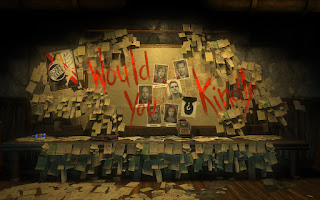5 Favourite Platformers
5 Favourite Platformers
Just visually Brothers looks like a
fairytale book brought to life: dwarves, trolls, giants and sinister wolves
populate the world. But it’s not hard to see past Brother’s child friendly
demeanour and find a game drenched in themes of grief, loss, the hope to keep
moving on and most importantly, family.
After a single father has become sick, it’s
up to two sons to venture across a fantasyland in search of a cure. It’s a
simple premise but it’s really the relationship that’s built between the two
brothers that makes the game such an endearing adventure. Throughout the world, anything that looks
remotely interesting, you can probably interact with, with both brothers.
Seeing both the older and younger one react to the same things differently is a
charming character building technique, but the moments where they’re
interacting or working with each other are the highlights of the game. They
have a natural bond that’s easy for anyone with a sibling to relate to. They tease each other, argue, play, joke and have primal instincts to protect one another. While
its narrative is excellent, it’s the games fantastical yet grounded tone that
puts it on the list. It walks the line between being heart warming and heart
wrenching. Human moments depicting the joys of life are just as profound as the
scenes of pure despair and hopelessness in the game. It really is a game that evokes emotion so effortlessly and will have you smiling as hard as it'll leave you crying.
4) Ori and the Blind Forest
At first glance Ori and the Blind Forest
looks like nothing more than a cute children’s game with an even cuter
protagonist. However, within the first 10 minutes the Pixar-esque opening will
be pulling on your heartstrings, amplified by a transcendent, orchestrated
soundtrack and a vibrant, naturalistic art style.
But Ori and the Blind Forest isn’t all
looks; it’s just as brutal as it is beautiful. Ori's airy but precise jumps are
accompanied by a whole collection of different moves that you can string
together consecutively, and Ori’s best moments are the ones that force you to
do this, almost without touching the ground once. The progression system walks
the line between giving you too much at once and nothing for long periods of time.
You’ll gain abilities at steady pace, helping you to slowly be able to juggle
all of Ori’s abilities. Most of the challenge is separated nicely with
stress-free exploration of the metroidvania forest and a handful of dungeons
filled with puzzles. There’s never a dull moment in the game thanks to its
stellar pacing, agile movement and superb atmosphere.
3) Celeste
The newest game on the list, Celeste, is
undoubtedly a modern masterpiece. Starting with its actual platforming; Celeste
is definitely one of the most precise games I’ve ever played, missing a jump by
just a few pixels can make all the difference, but of course this stops the
game from ever getting frustrating since every failure can only be blamed on
yourself. Pixel perfect jumps and dashes are only complimented by increasingly
difficult level design that leaves no room for error especially in its secret
levels. Each chapter presents you with a new challenge/gimmick: heavy winds that
affect your speed and direction of jumps, moving platforms that give you
momentum to cover ground etc. It’s a game that never feels repetitive.
For me however Celeste’s sweat-inducing
gameplay is only worth it because it’s married so well with a beautiful and
sensitive story about mental health. Our protagonist, Madeline, comes to climb
the titular Celeste Mountain to escape and deal with her anxiety and
self-consciousness. Celeste’s delicate and relatable writing accurately depicts
what it’s like to deal with self-doubt, but it’s more importantly the most
appropriate story to mirror the player's own struggles through the sometimes
seemingly insurmountable mountain, making the climb up Celeste mountain an even more intimate and relatable one. Jaw dropping pixel art, a nearly orgasmic
soundtrack and hours of extra content is just icing on the cake for the
spiritual experience that is Celeste.
2) Banjo-Kazooie
For a game approaching its 20th
anniversary, Banjo-Kazooie holds up incredibly well. Camera issues, which still
haunts many 3D platformers today, is surprisingly, almost never a major issue.
Aesthetically, while Banjo’s 64 bit graphics can’t compete with today’s games,
Banjo-Kazooie’s charming, cute art style endures while its endlessly catchy
tunes are exceedingly optimistic. However it’s Banjo-Kazooie’s boundless
charisma and creative design that’s helped it retain that ‘classic’ status two
decades later.
The entire world of Banjo-Kazooie is just
overflowing with personality. Banjo, the bear, carries Kazooie, the red bird,
in his backpack, making them literally attached at the hip. Banjo’s hilarious
dopey nature and ignorance is matched perfectly with Kazooie’s sarcasm and wit.
Their chemistry never takes a break and it’s a welcome departure from the
typically silent Italian plumber that dominates the genre. When the evil (and
ugly) witch Gruntilda kidnaps Banjo’s sister for her beauty, it’s up to the
endearing duo to venture into Gruntilda’s lair and meet a whole host of equally
entertaining anthropomorphic animals. It’s definitely a simple and cartoony
premise that works thanks to great writing.
It’s not just the game’s comedy that sets
it apart from most platformers, it’s the imaginative but expert level design.
Banjo might have all the clichés of a platformer: the ice world, the desert
world, the Halloween world, lava, island, swamp etc, but it never fails to put its
own twist on it. For example, the typical end world of a platformer, the lava
world, is instead transformed into a hilarious game show. Or the impeccable
Click Clock Wood level that features the same massive tree in four different
seasons across a year, changing each time based on your actions, essentially
incorporating time travel into a level. Plenty of collectibles keeps the game
at a steady non-stop pace. But it’s really Banjo and Kazooie’s combination of
moves and abilities that makes the game so much fun. If you can forget about
the game’s blocky, but still endearing, graphics, then Banjo-Kazooie’s one of
the most joyful adventures in gaming.
1) Inside
I’ve never played a game that manages to shock
as consistently as Inside. Similar to its spiritual predecessor Limbo, the game
begins with you taking control of young boy in the middle of the forest. What
follows can only be described as a nightmare in the best way possible: strange,
disturbing and unflinching. This doesn’t mean jump-scares however, sure, there
are more than a few heart-pounding moments, but Inside’s horror works not only
by getting under your skin, but into your head. Playing as the boy you
adventure through an Orwellian dystopia and deep into an uncanny science
experiment. It’s scary in the way the best dystopian stories are: different
enough to be entertaining but tangible to the point where it could - in theory
- be very real. Saying much more would be a spoiler, but saying much more is
also impossible without writing an essay full of theories about what actually
happened. Inside’s wordless narrative is as ambiguous as it is quite. It shows
you a lot without telling you anything, meaning you can interpret what you want
from its story; of course the most widely accepted fan theory online is
guaranteed to blow you away, but even if you don’t want to ponder its story and
piece it all together
However, Inside is a masterpiece because of
how it marries its narrative with its gameplay. Inside’s puzzles might not be
as complicated or intricate as Limbo’s, but they are believable and important
to Inside’s expert world building. While Limbo was full of generic switches and
boxes to push and pull, Inside’s puzzles focus on things in the environment
that would believably be there, and all of Inside’s puzzles or obstacles add to
another piece of the larger narrative puzzle trying to be clued together.
Inside also doesn’t present any significant platforming challenge that Limbo or
other games on this list might, but that works in the game’s favour. It’s more
about experiencing the story and not necessarily its mechanics. Limiting the
amount of deaths you have in the game is also an extra benefit since when it
does happen it’s horrifying. This all sits on the shoulders of the game’s
unparalleled animation and style: every object’s movement is, sometimes even
grotesquely, realistic.
Inside is a nearly peerless work of art
that can be enjoyed as a thrilling and cinematic sequence of events or as a
layered, complicated story with meaningful things to say. It’s a game, tonally
unlike any other; rendering plenty of haunting and powerful images guaranteed
to be burned into your memory. Poignant, yet disturbing, Inside is simply
unforgettable.










Comments
Post a Comment